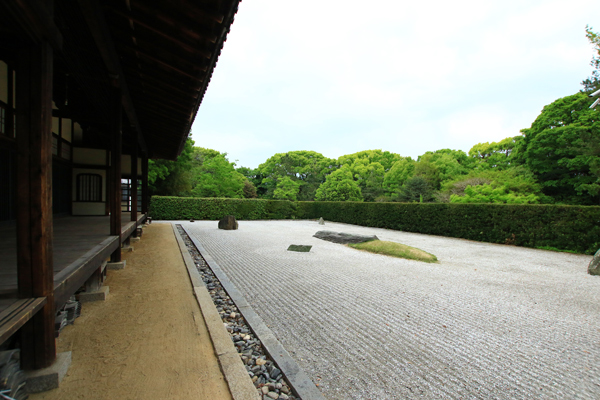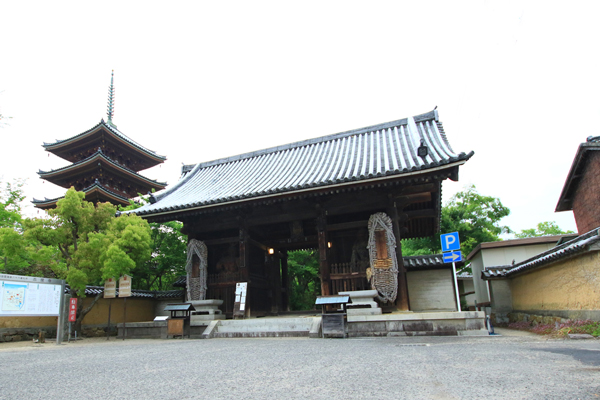The Shikoku Pilgrimage Temple Guide
Temple 86, Shidoji

Precinct map

History of the temple
Shidoji is located in the eastern part of Kagawa Prefecture on Shido Bay. Beyond the bay you can see the ridges of Yashima and Mt. Gokenzan. The temple was founded in 625. It is one of the oldest temples on the Shikoku Pilgrimage.
It is said that the temple was founded when Chikako, a member of a marine group, sculpted a statue of Juichimen Kannon Bosatsu (Eleven-faced Bodhisattva Who Hears the Sounds of the World) on a sacred tree and built a temple. Later, Fujiwara no Fuhito, son of Fujiwara no Kamatari, built a tomb for his wife and named it Shido Dojo. In 693 Fusasaki, son of Fuhito, together with Gyoki, expanded the temple area. The temple flourished as a center of learning. It is also the setting for the Noh play "Ama."
In the Muromachi period (1336-1573), the temple prospered thanks to a donation from the Hosokawa clan, the governors of Shikoku, but it was devastated in the Sengoku period (1467-1615). The temple was rebuilt in 1671 with support from Ikoma Chikamasa, a descendant of the Fujiwara clan, plus donations from Matsudaira Yorishige, the Lord of Takamatsu. Shido is the hometown of Hiraga Gennai (1729-1780), a polymath of the Edo period. A museum dedicated to his life and work is nearby.
Highlights
Niomon Gate
The temple gate is at the end of the main approach.This magnificent gate has a rare design called mitsumune-zukuri (three-sectioned building) and welcomes visitors with statues of the Ni-o (Two Guardian Kings) by Unkei and a huge pair of waraji (straw sandals). The Niomon Gate and the Hondo were financed by Matsudaira Yorishige, feudal lord of Sanuki (Kagawa). They are Nationally Designated Important Cultural Properties.
Statue of Enma
According to legend, Shidoji’s image of Enma, the King of Hell, has the same body as the principal image of Juichimen Kannon Bosatsu. This image of Enma has eleven faces of Buddha on his head. He is the deity of rebirth in the Pure Land. The statue of Enma in the Enmado is said to have been made by order of Enma himself in the middle of the Muromachi period (1336-1573). He wanted a life-size statue, so he took measurements of his own body and raised a nun named Mia from the dead. The face of Enma can look scary or kind, depending on the state of mind of the visitor.
Ama's Tomb
This tomb is related to a tragic story about the Fujiwara family. The story is also depicted in Noh plays. There are about 20 Ama's Tombs. They are said to have been built by Fujiwara Fusasaki for his mother. In the past, a market called Shidoji's 16th Market was held on July 16, the anniversary of Ama's death. On this day each year the principal image of Eleven-faced Kannon Bosatsu is unveiled.
Kyokusui-style garden, Muzentei
The Kyokusui-style garden was created in the Muromachi period (1336-1573) and is impressive for powerful stonework that soars toward the sky. Muzentei, located in front of the Shoin, was created by Shigemori Mirei, and is a typical Zen-style dry landscape garden, reminiscent of the famous dry garden of Ryoanji in Kyoto. (Free admission)

Annual Events
| January 15 | Dondoyaki |
| 2nd Sunday in May | Saito O-Goma (Outdoor goma fire ritual) |
| July 16th and 17th | Principal Image General Public Day |
| 2nd Sunday in December | Eitai Dosha Kaji Hoyo (Soil Memorial Service) |
| 17th of every month | Enmado General Public Day |
Details
Names: Fudarakusan Shidoji
Denomination: Shingon sect, Zentsuji school
Principal Image: Juichimen Kannon Bosatsu
Founder: Fujiwara no Fuhito
Founded: 625
Access
Address: 1102, Shido, Sanuki City, Kagawa 769-2101
Phone: 087-894-0086
Parking: Available (free of charge)
Lodging: None
Official website: None
